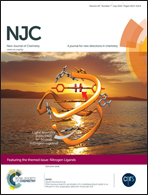Light-driven charge transfer in nano-Fe(iii) complexes facilitates the oxidation of water†
Abstract
The design and preparation of highly active, environmentally friendly photo-catalysts with low cytotoxicity for the oxidation of water are important in achieving the efficient splitting of water. We present a novel supramolecular nanocomplex BODIPY@Fe1 obtained by assembling a flower-like nano-Fe(III) complex (PPM@Fe) with 8-(4-methoxyphenyl)boron-dipyrromethane (BODIPY) through a hydrogen bond. This complex catalysed the oxidative conversion of water to dioxygen. The hydrogen bond C![[double bond, length as m-dash]](https://www.rsc.org/images/entities/char_e001.gif) O⋯H(N)–F– facilitated the charge transfer interaction between the ligand and the metal centre in BODIPY@Fe. The TOF value of BODIPY@Fe/H2O (7.76 h−1) was much higher than that of the PPM@Fe/Ru(bpy)3Cl2/Na2S2O8 system (3.06 h−1). Electron paramagnetic resonance spectrometry and water oxidation activity data indicated that the high-spin Fe(III) species in the BODIPY@Fe complex was involved during the catalysed oxidation of water. The formation of the Fe–O and O–O bonds were confirmed. BODIPY@Fe can also catalyse the oxidative degradation of methylene blue using water as the oxygen source. Hence the assembly of a photosensitizer with an Fe(III) complex of pyrrole-conjugated carbonyl group derivatives provides a promising green generator of dioxygen via photoirradiation.
O⋯H(N)–F– facilitated the charge transfer interaction between the ligand and the metal centre in BODIPY@Fe. The TOF value of BODIPY@Fe/H2O (7.76 h−1) was much higher than that of the PPM@Fe/Ru(bpy)3Cl2/Na2S2O8 system (3.06 h−1). Electron paramagnetic resonance spectrometry and water oxidation activity data indicated that the high-spin Fe(III) species in the BODIPY@Fe complex was involved during the catalysed oxidation of water. The formation of the Fe–O and O–O bonds were confirmed. BODIPY@Fe can also catalyse the oxidative degradation of methylene blue using water as the oxygen source. Hence the assembly of a photosensitizer with an Fe(III) complex of pyrrole-conjugated carbonyl group derivatives provides a promising green generator of dioxygen via photoirradiation.


 Please wait while we load your content...
Please wait while we load your content...